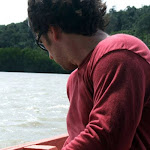
Ate breakfast of giant, delicious fruit salad covered with muesli and yogurt, served with quite possibly the worst coffee I've ever tasted. Note for future reference: when in Peru, never order the Cafe Moka. Does NOT taste like cafe mocha; tastes like watery coffee mixed with heaping spoonful of bittersweet chocolate cooking powder. Bleah. As El Profesor said, it was an ¨ethnographic experience.¨



Bought our bus tickets to Chiclayo and then went to the plaza to catch our tour to Kuelap. Our group consisted of a young British couple who writes for the TimeOut travel guides, a family of four from the north of France, and our guide Hernando. We all knew just enough of the three languages represented to communicate and have a great time.
The parking area at Kuelap is a 20-minute hike from the ruins. There was a woman offering horseback rides for 5 soles, and I couldn't resist. I´m not sure it was easier than hiking - trying to stay upright on a horse that´s climbing straight uphill on the very edge of a mountain was, uh, challenging - but I loved the experience.

I was stunned when we emerged from the trees and I saw the fortress walls for the first time. I've seen lots of photos, but nothing prepares you for the sheer scale of the place.
We walked all over the fortress visiting the common and noble living areas as well as the apu's (leader´s) house .
The structures are mostly conical, and there are holes in the floors or in the walls where family members were buried so they could be near and keep a close watch.

Bromeliads covered the trees, and hummingbirds zipped about overhead. A shepherd wandered about the ruins trying to round up his llamas. After a couple of hours, we piled back in the van and drove home, stopping at a small restaurant along the way for a late lunch of fried trout, papas fritas, and fried plantains.

Returned to the travel office in the plaza and said our goodbyes. Petrova, the 13-year-old French girl, and I exchanged email addresses so we can practice our English and French with each other. Tomorrow, we´re going to try to find that site I´ve been babbling about for months; it´s only about an hour away, should be accessible by road, and we´ve got the lat-long coordinates. Then we´ll board an overnight bus to Chiclayo at 7:30. We´ll wander about Chiclayo on Friday until it´s time for our 10pm flight to Lima. Then back home Sunday morning!



 When we finally made it out of the forest and into the sunlight, we abruptly found ourselves on the edge of a deep ravine - there was no way we could make it to the other mountain today. So we forced our way back through the forest until we came to an opening where we could safely work our way down the mountain. When we walked out of the forest, we ran into a farmer and asked him for directions to the road back to town. I can't even imagine what he must have thought when the two filthy gringos magically appeared out of nowhere.
When we finally made it out of the forest and into the sunlight, we abruptly found ourselves on the edge of a deep ravine - there was no way we could make it to the other mountain today. So we forced our way back through the forest until we came to an opening where we could safely work our way down the mountain. When we walked out of the forest, we ran into a farmer and asked him for directions to the road back to town. I can't even imagine what he must have thought when the two filthy gringos magically appeared out of nowhere.

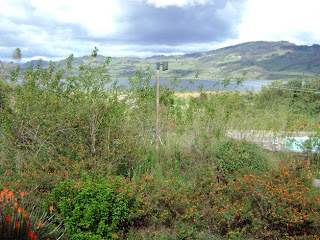 After a brief rest, El Professor and I walked down the main street looking for a place to eat dinner. Very little was open since it was Sunday night, so we stopped at a shop and bought Andean cheese, fresh rolls, sugar cookie balls, and jam-filled cakes that tasted like fruity Moon Pies. Ate dinner back at the hotel and reminisced about our friends and family. Now I miss my peeps.
After a brief rest, El Professor and I walked down the main street looking for a place to eat dinner. Very little was open since it was Sunday night, so we stopped at a shop and bought Andean cheese, fresh rolls, sugar cookie balls, and jam-filled cakes that tasted like fruity Moon Pies. Ate dinner back at the hotel and reminisced about our friends and family. Now I miss my peeps.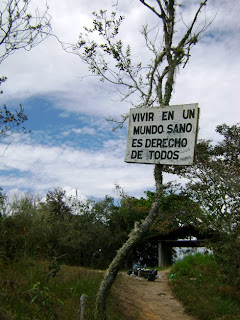
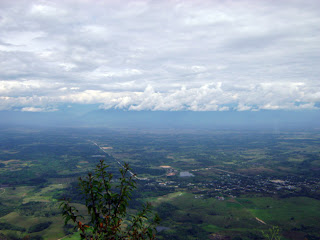 The only big, fat downer of the day was that I blew my left knee on the descent. Thankfully El Squid, my beloved brace, was with me, so I was able to make it down by bracing the left leg and putting all my weight on the right. Ow, quit it. Tomorrow is a travel day though, so I should be good as new after a day of rest. And enough Tylenol to kill a horse.
The only big, fat downer of the day was that I blew my left knee on the descent. Thankfully El Squid, my beloved brace, was with me, so I was able to make it down by bracing the left leg and putting all my weight on the right. Ow, quit it. Tomorrow is a travel day though, so I should be good as new after a day of rest. And enough Tylenol to kill a horse.




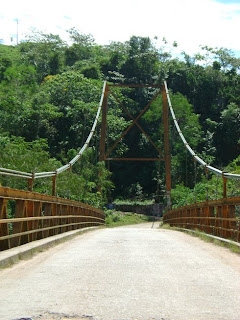


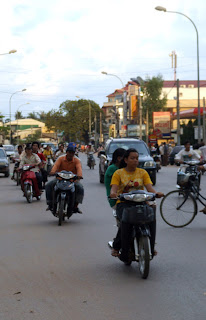


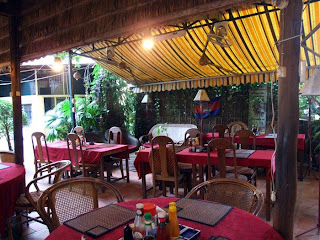



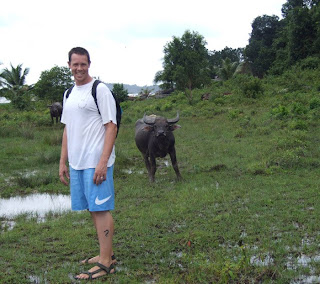
 Ate breakfast at our Guesthouse -- lemon honey crepes for me; potato puff, bacon, eggs, toast, juice and coffee (aka "The American") for Brad. Then Brad and the gang walked to Serendipity Beach* and back while I sat in a papasan chair at Dara's. The fever has finally broken, but I'm still feeling weak, and Dara's was just what the doctor ordered. I sat in that chair for seven straight hours with only a short swim in the Gulf to break up the day. I took a magazine with me, but every time I opened it, I thought, "I could be staring at the Gulf of Thailand." So I did. Despite the steady stream of beggars, children, pedicure hawkers, and musicians, it really was quite relaxing.
Ate breakfast at our Guesthouse -- lemon honey crepes for me; potato puff, bacon, eggs, toast, juice and coffee (aka "The American") for Brad. Then Brad and the gang walked to Serendipity Beach* and back while I sat in a papasan chair at Dara's. The fever has finally broken, but I'm still feeling weak, and Dara's was just what the doctor ordered. I sat in that chair for seven straight hours with only a short swim in the Gulf to break up the day. I took a magazine with me, but every time I opened it, I thought, "I could be staring at the Gulf of Thailand." So I did. Despite the steady stream of beggars, children, pedicure hawkers, and musicians, it really was quite relaxing.


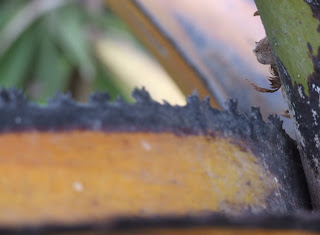



 Then we walked around the market one last time before catching the bus to Phnom Penh.
Then we walked around the market one last time before catching the bus to Phnom Penh. 

